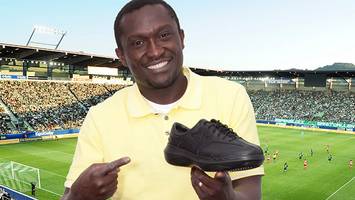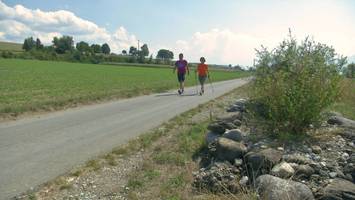Unstable ankles, loose ligaments
Ankle instability can arise if the ligaments have been strained or torn and have remained too loose after growing back together (mechanical instability). It can also be linked to an impairment of the interaction between the joint bones and the surrounding ligaments and muscles. This phenomenon is also described as a
kinaesthetic disorder (impairment of proprioception).
Proprioception plays a decisive role in our bodies’ movement processes; it is a partially unconscious function. A constant feeling of instability in the ankle may not only be due to strained ligaments, but also to a kinaesthetic disorder or a muscle coordination disorder.
kybun allows you to train foot coordination during your everyday routine without spending extra time, and this improves foot proprioception. It facilitates the interplay between muscles and ligaments, actively stabilising the foot.
Acute or chronic pathological looseness of the upper ankle due to insufficient ligamentous and/or neuromuscular (proprioception) stabilisation capability.
Acute upper ankle instability is caused by a traumatic ligament rupture. This can affect either the lateral ligamentous complex (anterior talofibular ligament, fibulocalcaneal ligament), the medial ligamentous complex (deltoid ligament, spring ligament) or both. The most common disorder is lateral upper ankle instability caused by a supination inversion trauma.
An ankle sprain can lead to
permanent (chronic) joint instability. An ankle is considered chronically unstable if the joint still yields easily six months after the first sprain, or if it suffers additional sprains. An unstable joint can twist again more easily. About 10 to 20 per cent of those who sprain an ankle suffer from unstable ankle joints thereafter.
Despite high-quality conservative therapy measures for acute upper ankle instability, about 20 per cent of cases develop
chronic upper ankle instability, which ends in
post-traumatic upper ankle osteoarthritis if left untreated.
There are various treatment options for ankle instability:
- Initial efforts focus on functional treatment: physiotherapy and possibly the prescription of a brace. So-called neuromuscular training is also very common. It focuses on improving ankle power, stability and coordination.
- If the joint remains unstable despite training because the ligaments are too loose, surgical shortening can solve the problem.
- Even if a problem in the interior of the joint can be corrected surgically, muscle coordination will probably have been impaired during the lengthy period of instability. That is why rehabilitation exercises are always an important part of treatment following an operation.
People with unstable ankles
used to receive prescriptions for stabilising shoes. Today we know that this does not treat the cause and actually increases foot instability. That is why this method only makes sense immediately following a severe trauma or when instability is very great and no longer treatable.
The fact that Künzli shoes, insoles and braces are still frequently prescribed has persuaded many people that unstable ankles must be stabilised.
Many customers with loose ligaments assume incorrectly that the kybun mat/kybun shoe is not suitable for them, but the opposite is true:
unstable ankles/loose ligaments can only be trained on an unstable surface (such as the kybun mat/kybun shoe)! In physiotherapy, many coordination exercises are also carried out on unstable platforms (balancing board, etc.) in order to train foot proprioception and coordination.
The kybun principle of operation – being proactive
If you have an unstable ankle, it is important to start active proprioception training as soon as acute pain is alleviated and the swelling has gone down in order to improve foot coordination. Foot coordination is always impaired after an injury, and it is important to correct this impairment quickly in order to
prevent subsequent injuries to the feet.
Thanks to the soft, elastic material of the kybun shoe sole and the kybun mat, the
impact from hard floors is absorbed. Since this makes kybun training very gentle, you can start with it soon after incurring the injury. The kybun mat is especially well suited in the acute and early sub-acute stage, since the exercises can be specifically adapted.
The foot can move freely and naturally in all directions on the soft, elastic kybun shoe sole/kybun mat. This forces the foot to use its musculature to stabilise itself. Small movements take place in the foot at every step, gradually strengthening it. This
intensive training significantly improves foot coordination/proprioception, and you feel safer and more stable. You will notice a difference after just a few applications.
Foot mobility and
circulation are improved thanks to the fine movements on the soft, elastic material. This is very important, especially after an injury, in order to prevent agglutination and scar formation and to promote healing.
Specific initial reactions with unstable ankles/loose ligaments:
In the beginning, it is possible that you might feel very unsteady while using the kybun shoe sole or the kybun mat, or that you feel as if you are tipping to one side. This is entirely normal and a sign that your feet are unstable and require training. While the soft, elastic material often feels very unsteady at first, this gets better as your feet gain more stability. Please follow the tips under ‘Application tips’ and seek advice from your local kybun dealer if the initial reactions do not improve.
Click here for the general initial reactions experienced by kybun mat and kybun shoe beginners:
Initial reactions
For information about the special kybun shoe exercises or the basic kybun mat exercises, please click here: kybun exercises
The following
adaptations to the standard implementation of interval walking are important in case of
unstable ankles :
- Focus on slow exercises to promote muscle coordination (the better the coordination, the better the stability)
- If you notice that you are becoming fatigued, transition immediately to fast exercises to allow your musculature to recover.
- Selecting the right dosage is very important in the beginning – adjusting the length of time you use the kybun shoe/kybun mat to your personal needs. It is better to walk shorter distances on ordinary surfaces at first, so your body can adjust to the challenge of walking with the kybun shoe/standing on the kybun mat.
- Gradually increase the duration of use at your discretion until the strength and coordination of your feet is sufficient for walking in the kybun shoe for several hours. For some people, this is possible after just a few days while others take longer. It is highly individual.
The kybun shoe is a training device and can, but does not have to, become an everyday shoe later. - Be sure to maintain correct foot position on the kybun mat/in the kybun shoe. This means that the foot should stand straight on the soft, elastic material without lateral/medial rolling of the ankle joint. Any lateral/medial rolling of the ankle joint on the kybun mat/in the kybun shoe is usually not the fault of kybun but is caused by foot weakness, which has to be gradually alleviated through training. You will notice immediately when you place one-sided strain on your feet because the sole yields in the corresponding area.
- Try to focus on the foot position and correct lateral/medial rolling of the ankle joint. This strengthens your foot musculature so that, with time, you no longer tip sideways. Make sure that your body does not cramp up. Read more under ‘Lateral/medial rolling of the ankle joint’.
- Be sure not to take steps that are too long; that makes it easier to stabilise the foot over the kybun shoe sole and reduces the tendency towards lateral/medial rolling of the ankle joint.
- If walking upright in the kybun shoe is no longer possible or you notice that you are ‘standing beside the shoe’ and are unable to correct this any longer, take this as a sign of body fatigue that means that you should take a short break from the kybun shoe.
- If your foot musculature is weak, it may make sense to acquire a model with a lower rebound effect when you first purchase the kybun shoe. This sole is more stable in the midfoot section. (Please consult your kybun dealer for further information.)
- Try various kybun shoes; some models with a higher cut provide more stability.
- If you still feel too insecure walking in the kybun shoe, the kybun mat is the ideal training device for the careful development of the foot musculature. Please give your body time, and do not give up too quickly.
The kybun mat is available in three different thicknesses. This allows you to choose the thickness that is most comfortable for you (the thicker, the more unstable, the more intensive the training).
You can also hold on to a fixed object if you need additional support when using the kybun mat.
Opinions/customer testimonials
On October 1993 I did a forced landing near an air field at the northern part of Israel. On take off, and few minutes air born I've noticed a sudden engine cut, did a rapidly forced landing in a very bad field for landing, plenty of boulders and rocks. In these circumstances you can choose the right place - you take what you find. Fortunately the passenger didn't suffer any damage,but I broke badly my right ankle.
It took me one year and a half of crutches and 3 orthopaedic operations to walk again. Until now I couldn't find suitable shoes though I tryed all possible firms and styles. I could walk, but always with pain and uncomfortable sensation. Two months ago a friend from Israel,and shoed me his shoes, which was of your production. I tried them and felt good.
I use those shoes for about one month and a half now,and for the first time after the incident I can walk again without lame ,pain or inconvenience and for relatively long courses even up the hill side.
So, in short ,I am very happy now with your shoes and will buy some others for the next winter.
"Proprioception (our sense of our body's movements and relative position) and proprioceptive training are very important to avoid injury. The kybun shoe is an effective tool for such training sessions; it can be worn the whole time and is very comfortable. It means that you are involved in a kind of constant training session without having to make a lot of effort. In the end I was able to try out the effect myself. Without any specific therapy, just from wearing the kybun shoe, I was able to cure my Achilles tendonitis: the unstable sole strengthened the muscles stabilising my ankle joints, taking the burden off the rest of my overstressed muscles. I recommend the kybun shoe following injuries to the lower extremities, for jobs in standing positions, for sportspeople and for the elderly, to prevent falls."












